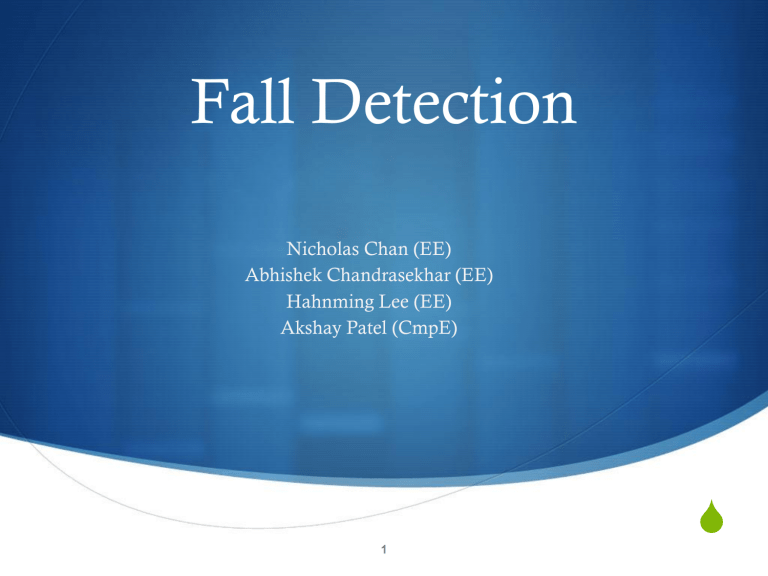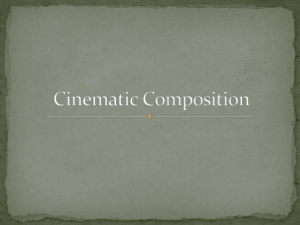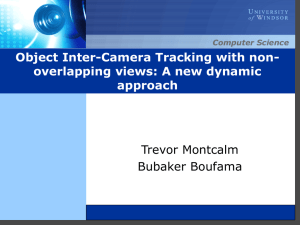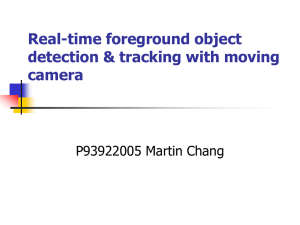PPT

Fall Detection
Nicholas Chan (EE)
Abhishek Chandrasekhar (EE)
Hahnming Lee (EE)
Akshay Patel (CmpE)
1
S
Elderly Fall Statistics
S 16,000 elderly Americans die from falling each year (CDC,
2005)
S 300,000 elderly Americans have hip fractures each year
S 90% of hip fractures result from falls
S 24% of elderly Americans who suffer hip fractures die within one year
S 40% of elderly women with hip fractures never walk unassisted again (National Osteoporosis Foundation)
2
Proposed Solution
S Two camera system executing custom algorithm:
1.
Detect person in room
2.
Perform statistical analysis of person’s motion
3.
Determine if a fall has occurred
4.
Send an alarm for help
S Projected cost of $500 per room
3
Target Market
S
Smart Hospital Rooms Nursing Homes & Clinics
Our solution offers to reduce injuries arising from falls and to improve safety records at nursing homes and hospitals.
4
Alternative Solutions
S Pressure-sensitive mats by the bed
S Camera detection with optical flow algorithm
S RFID Solutions
S Accelerometers (e.g., iLife ™)
5
Alternative Solution Problems
S Pressure sensitive mats have unavoidable edges that can
cause falls
S Optical flow analysis prone to errors arising from shadow artifacts
S Potential EMI interference from RFID readers; RFID readers also very expensive (over $1000)
S Accelerometer results in many false positives (e.g. a person sitting down quickly)
6
Technical Specifications
S Two webcams (Microsoft VX 6000)
S
S
Resolution of 160x120 pixels
Video recorded at 15 frames per second
S Personal Computer to run algorithm:
S
S
S
Intel Pentium Dual Core 2.5GHz Processor
3GB RAM
Standard Keyboard and Mouse
7
Camera Positioning
S Privacy is a major concern
S Gaining maximal coverage from camera position is also critical
S A balance between these two must be achieved
8
High-level camera
Camera Positioning
Maximal Coverage
Head-level Camera
Coverage Area
9
Knee-level camera
High-level camera
Camera Positioning
Maximal Privacy
Coverage Area
10
Algorithm Overview
1.
Identify the region of an image occupied by the person
2.
Ascertain the velocity of the person’s motion
3.
Fit an ellipse to the person
4.
Analyze the changes in the ellipses’ properties
5.
Determine if a fall has occurred
11
Foreground Segmentation
S The background of every frame is subtracted
S Statistical Gaussian model is generated for each pixel
S HSV color space is used to minimize shadow effect
S Pixels are labeled as either foreground or background based on a preset threshold
S A binary foreground image is thus generated
12
Foreground Segmentation
Foreground
Segmentation
Foreground
Segmentation
13
Foreground Segmentation
Foreground
Segmentation
14
Largest Blob Detection
S Additional filtering is performed on the foregroundsegmented image
S The largest continuous cluster of pixels is detected and then isolated from the smaller clusters of noise
15
Largest Blob Detection
Blob Detection
Blob Detection
16
Motion History Imaging
S Filtered foreground-segmented image data used to form
Motion History Image (MHI)
S MHI used to quantify the velocity of the person’s motion
S 0 (zero velocity) ≤ C motion
≤ 1 (extreme velocity)
17
Motion History Imaging
Turning Around
( Low C motion
)
Swiftly Walking
( Medium C motion
)
Falling
( High C motion
)
C motion
number gray pixels number gray number white pixels
18
Elliptical Approximation
Frame 1
Normal Walking
Change in
Ellipse Angle
19
Frame 150
Mid-Fall
Elliptical Approximation
Frame 120
Normal Walking
Change in
Eccentricity
20
Frame 150
Mid-Fall
High
Frequency
Noise
Elliptical Approximation
Angle
2
1.5
Possible
Fall
1
0.5
0
0 50 100 150 200
Frame
250
Eccentricity
300 350 400 450
4
3
2
1
0 50 100 150 200
Frame
250 300 350 400 450
Statistical Analysis
S Falls result in:
1) high-velocity motion (high C motion values) and
2) large statistical variance in elliptical orientation/eccentricity
S Numerically, we define a fall is defined by:
C motion
> 0.65 and σ
θ
> 0.60
S These thresholds may vary slightly with camera position
22
Statistical Analysis
C motion
> 0.65
σ
θ
> 0.60
23
Call for Assistance
S Computer connected to Ethernet network
S When fall happens a picture is taken
S A fuzzy picture is stored to a local server
S An updating intranet page is displayed at the nurse station
S The page incorporates archiving features
S Nurse analyzes picture and determines if a response is necessary
24
Call for Assistance UI
Page refreshes every 5 seconds to check for screenshot on the server
25
Call for Assistance UI
When a fall occurs a flashing red message along with a screenshot is displayed
26
Archiving Falls
S The shot can be archived with a date stamp onto the local server
S The detected fall log shows a queue of falls that happened
S On archiving and reloading the system shows normal status again
27
Results
Category
Falls
Non-Falls
% Success
83.33 %
75 %
% Failure
16.66 %
25 %
S Results are based on evaluation of 30 falls and 20 non-falls
28
Problems and Solutions
S Hardware and Software Problems:
S
S
MATLAB requires substantial memory to execute programs
Algorithm has difficulty accounting for auto-light adjustments by the webcam
S Solutions Proposed:
S
S
Port existing algorithm to C++ in order to run it more efficiently; using C++ also removes the licensing hassles required with
MATLAB
Light intensity can be normalized with histogram equalization techniques; alternatively use a webcam without light adjustment
29
Real-Time Analysis
S Existing Problems:
S
S
MATLAB is incapable of running threaded applications
Analysis and recording of video simultaneously is almost impossible as a result
S Solution:
S
S
S
Use C++; Supports threading and memory management
Real time analysis is available via OpenCV library
Many MATLAB functions are implemented in the library
30
Privacy Concerns
S Use of cameras brings in a major privacy concern
S Different configurations are necessary for concealment
S Terms & Conditions have to be included in hospital paperwork
S The picture taken of the patient upon a fall is blurred
S An option of not having the system on should be implemented if requested by the patient
31
Cost Analysis
S Assuming a rate of $28/hr, Engineer salaries would amount to $44,800 for 4 engineers during a 10 week development phase
S Equipment Cost:
S
S
$60 for two cameras
$270 for a modern Dell Inspiron 530
S $170 Installation and Software Costs
S Total Cost per Room = $500
32
Future Improvements
S Enable support for multiple people
S Improve speed of algorithm
S Reduce false positives by making a self-learning system
S Make the program standalone for easy deployment
S Enable mainframe support for hospital with servers
33
Questions?
S 16,000 Americans die from falling each year
S 300,000 elderly Americans have hip fractures each year
S 24% elderly Americans who suffer hip fractures die within one year
Category
Falls
Non-Falls
% Success
83.33 %
75 %
34
% Failure
16.66 %
25 %











